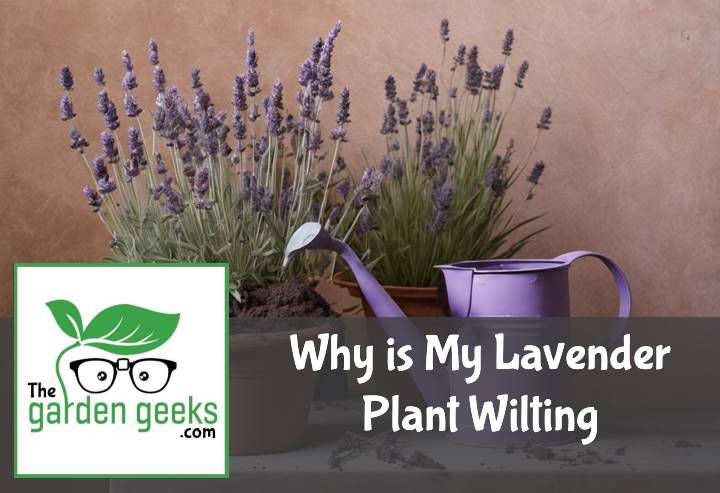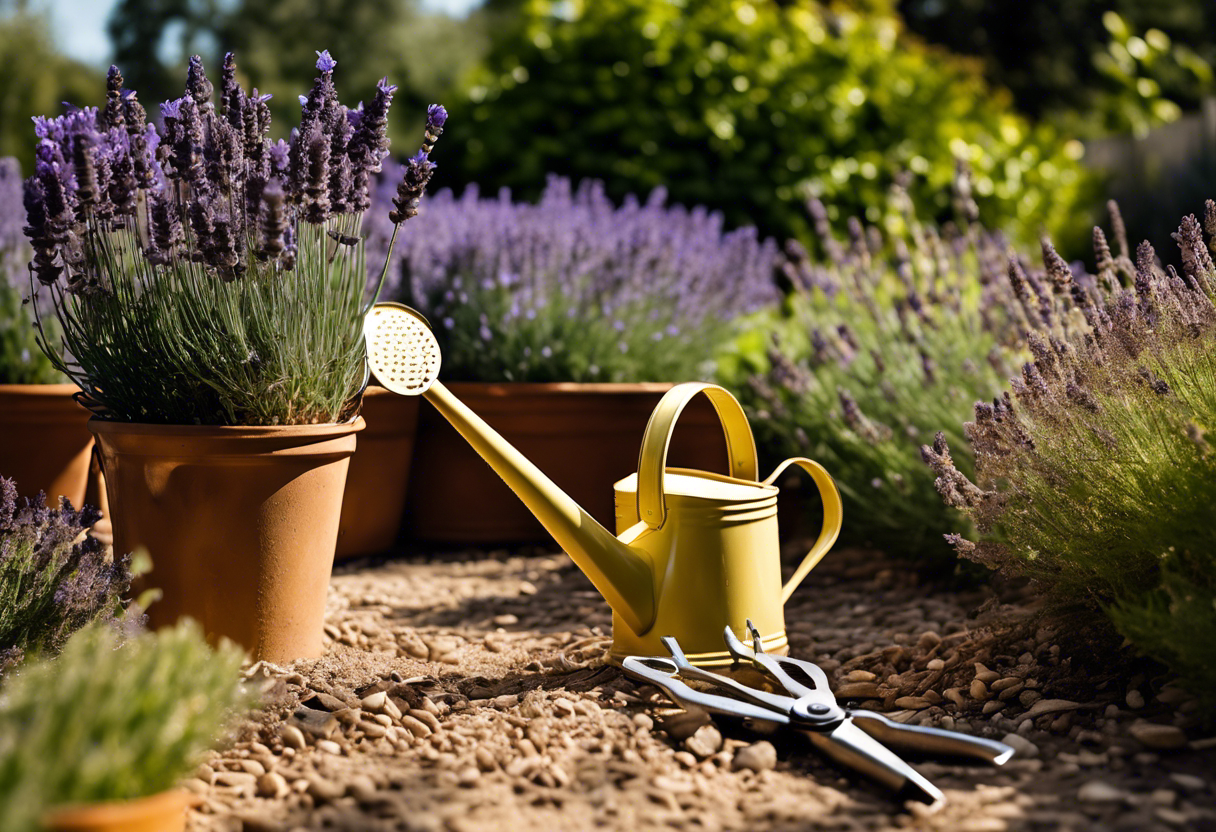Ever strolled through your garden, coffee in hand, only to stop dead in your tracks because your once vibrant lavender plant now looks more like a wilting willow? I’ve been there too, friend. You can’t help but wonder, “Why is My Lavender Plant Wilting?”
Well, buckle up buttercup! We’re about to dive into the nitty-gritty of lavender plant care and troubleshooting. So put on your gardening gloves and let’s get down to business! Keep reading about ‘Why is My Lavender Plant Wilting? (How to Solve it)’.
Key Takeaways
- Lavender plants may wilt due to overwatering, poor drainage, or a lack of sunlight.
- Overwatering can lead to root rot which causes wilting. Water only when the soil is dry.
- Poor drainage can also cause root rot. Ensure your lavender is planted in well-draining soil or a pot with drainage holes.
- Lavenders need full sun for at least 6 hours a day. Lack of sunlight can weaken the plant leading to wilting.
- Address these issues to revive your wilting lavender plant.
Why is My Lavender Plant Wilting?
Well, there could be a multitude of reasons why your lavender plant might be wilting. It could be due to environmental factors or even diseases. Lavender plant care isn’t always straightforward, and sometimes, despite our best efforts, we end up with a wilting lavender on our hands. But don’t worry! We’ll delve into these issues and how to tackle them in the following sections.
Understanding the Nature of Lavender Plants
First off, let’s get to know our lavender plants a bit better. These beauties have certain characteristics that make them prone to wilting. They’re like the divas of the plant world – they need their conditions just right.
The preferred lavender growing conditions include plenty of sunlight and well-drained soil. If they don’t get what they want, they show their displeasure by wilting. It’s their way of throwing a tantrum!
It’s also important to understand that plants have stress responses too. When lavenders are stressed (yes, plants can get stressed!), they might start wilting as a cry for help.
So, understanding these lavender care requirements is key in preventing your plant from wilting and keeping it happy and healthy.
Common Signs of a Wilting Lavender Plant
Now that we’ve covered some basics about lavender plants let’s talk about how you can tell if your lavender is wilting.
One common sign is changes in leaf color or shape. If you notice your lavender leaves turning yellow or brown or curling up at the edges, it might be time to play detective and figure out what’s causing this distress.
Another sign could be an overall change in the appearance of your plant. A healthy lavender should stand tall and proud with vibrant purple flowers. But if it starts looking droopy or its flowers lose their luster, then you might have a wilting plant on your hands.
Remember, identifying sick plants early can make all the difference in reviving wilting plants. So keep an eye out for these signs and act swiftly to save your lavender!
What Causes Lavender Plants to Wilt?
Ever wondered, “Why is my lavender plant wilting?” Well, there are several reasons for this. Let’s dive into the common lavender plant wilting causes.
Inadequate Watering
Overwatering or underwatering your lavenders can lead to wilting. It’s a classic case of too much love or not enough! Overwatering can cause root rot, while underwatering leaves your plants parched. Both scenarios result in a sad, wilted lavender.
The key is finding that Goldilocks zone of proper watering for lavenders. This means watering when the top inch of soil is dry and ensuring good drainage to avoid waterlogged roots.
Poor Soil Conditions
Soil conditions play a significant role in the health of your lavender plant. If you’re dealing with poor soil conditions, it’s like trying to grow a prize-winning rose in sand – it just won’t work!
Lavenders thrive in well-draining soil with an appropriate pH level. So, if you want happy lavenders, pay attention to their soil requirements and make sure they’re not stuck in mud or acidic dirt.
Insufficient Sunlight Exposure
Like most plants, lavenders need their daily dose of sunshine. Without sufficient sunlight exposure, they start to wilt faster than ice cream on a hot day.
Lavenders require full sun for at least six hours each day. So if your plants are looking a bit droopy, check their sunbathing schedule and adjust accordingly.
Overcrowding and Lack of Air Circulation
Overcrowding and lack of air circulation can also cause your lavender plants to wilt. It’s like being stuck in a crowded elevator on a hot day – not fun!
Proper spacing between plants allows for better air circulation and reduces the risk of disease spread. So give your lavenders some breathing room and they’ll thank you with lush, fragrant blooms.
Disease and Pest Infestation
Last but not least, diseases and pests can lead to wilting in lavender plants. It’s like your plants are under attack from tiny, invisible invaders!
Common culprits include fungal diseases and pests like aphids or whiteflies. Regularly inspect your plants for signs of disease or pest infestation to catch any problems early. Remember, a healthy lavender is a happy lavender!
How Can I Prevent My Lavender Plant from Wilting?
Let’s talk about some ways to keep your lavender plant from throwing a fit and wilting on you. It’s all about lavender plant care and making sure you’re doing everything right to prevent wilting lavender.
Proper Watering Techniques for Lavender Plants
First things first, watering. You might think it’s as simple as pouring water on the plant, but nope! There’s a science to it. Watering lavender plants is all about balance. Too much water and your plant will drown, too little and it’ll dry out. So, what’s the secret? Well, lavenders like their feet (roots) dry, so make sure the soil is almost dry before you water again.
This helps prevent overwatering, which is a common cause of wilting. The trick is to provide optimal watering for lavenders, ensuring they get just enough hydration without turning the soil into a swamp! Remember, consistency is key here; stick to a regular watering schedule for lavenders and your plant should stay happy!
Choosing the Right Soil for Your Lavender
Next up: soil selection. This isn’t just dirt we’re talking about; it’s the foundation of your lavender’s home! The best soil for lavenders is well-draining with plenty of grit or sand mixed in.
Why? Because this type of soil helps prevent wilting with right soil by allowing excess water to drain away quickly, preventing root rot. So when preparing your garden or pot, consider these suitable soil types for lavenders and give your plant the best chance at healthy growth!
Ensuring Adequate Sunlight for Your Plant
Sunlight – it’s not just for sunbathing! Your lavender needs its fair share too. Understanding the sunlight needs of lavenders is crucial for their survival. These little guys love the sun, so make sure they get at least 6 hours of it each day.
Providing adequate sunlight for lavenders helps them produce those lovely purple flowers and that wonderful scent we all love. So, keep your plant in a sunny spot to ensure good sun exposure and lavender health!
Maintaining Proper Spacing and Air Circulation
Now let’s talk about personal space – your lavender needs it too! Lavender plant spacing is important to prevent overcrowding and promote healthy growth. Plus, good air circulation can help prevent wilting with proper spacing.
So when you’re planting your lavenders, give them enough room to breathe. This will help prevent disease spread and ensure each plant gets enough light and air.
Protecting Your Plant from Diseases and Pests
Finally, let’s not forget about those pesky pests and diseases. They’re like the uninvited guests at a party who just won’t leave! Common lavender plant diseases include root rot and fungal infections, while pests can range from aphids to whiteflies.
But don’t worry, there are ways to protect your lavender! Regular inspections, using organic pesticides, or introducing beneficial insects can all be part of your strategy for protecting lavenders from pests. Remember: a healthy plant is a happy plant!
Reviving Your Wilting Lavender Plant: A Lifesaver Guide
So, you’re asking yourself, “Why is My Lavender Plant Wilting?” Well, don’t fret! Here’s a handy guide to help you breathe life back into your lavender.
Adjusting Watering Practices
First things first, let’s talk about watering. Lavender watering needs are pretty specific. These plants are like Goldilocks – not too much water, not too little, but just right.
Overwatering can cause root rot which leads to wilting. On the flip side, underwatered lavenders show similar underwatered lavender symptoms like drooping leaves. So what’s the solution?
Well, proper watering for lavenders involves letting the soil dry out between each watering session. This prevents both over and under-watering issues.
Improving Soil Conditions
Next up is soil conditions. Poor soil health can lead to wilting faster than you can say “lavender.” Lavenders need well-draining soil with a neutral to slightly alkaline pH level.
To improve your soil for lavenders, consider adding compost or organic matter to enrich it. This will create a healthy soil for lavender growth, preventing any future wilting episodes.
Increasing Sunlight Exposure
Sunlight exposure is another biggie when it comes to reviving wilting lavender. These plants love the sun and need at least 6 hours of it daily.
If your plant isn’t getting enough light, try moving it to a sunnier spot or using grow lights indoors. Remember, meeting the lavender sunlight needs is crucial for their survival and growth.
Thinning Out Overcrowded Plants
Overcrowding is another common culprit behind wilting in lavenders. When plants are too close together, they compete for resources leading to stress and eventual wilting.
The remedy? Thinning out lavenders. By giving each plant enough room to grow, you’ll avoid overcrowding issues and promote healthier, happier plants.
Treating Diseases and Pests
Last but not least, we have diseases and pests. These little buggers can cause a lot of damage to your lavender plants, leading to wilting.
Common culprits include fungal diseases and pests like aphids or whiteflies. To combat these issues, consider using organic pesticides or fungicides. Regularly inspecting your plants can also help catch any potential problems early on.
And there you have it! With these lavender care tips, you’ll be well on your way to reviving your wilting lavender plant in no time.
To Wrap Up
Just like a toddler who’s had too much sugar, your lavender plant can wilt from overindulgence (too much water) or neglect (too little). Hopefully, our post on Why is My Lavender Plant Wilting helped you find the balance.
Remember, it’s not rocket science. Keep an eye on watering, sunlight and soil conditions. Your lavender will thank you with its vibrant colors and heavenly scent!





